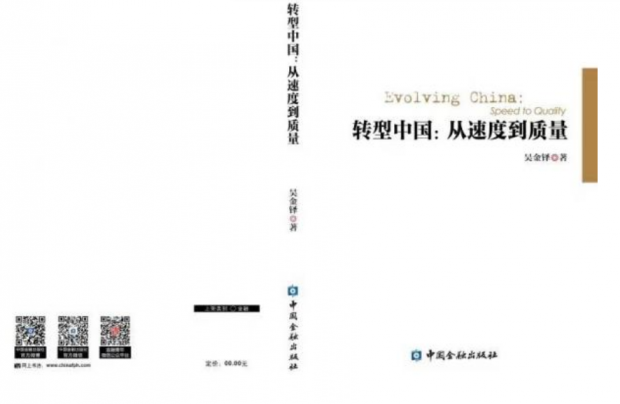Evolving China:Speed to Quality / 转型中国:从速度到质量
吴金铎 著
自改革开放以来,中国经历了四十多年经济的持续高速增长期。中国凭借人口红利带来的低成本劳动力充分供给优势、高资本积累率和高投资率、跻身全球产业链并共享全球化红利等,形成了一套有中国特色的发展模式。然而随着世界经济进入新常态,这种发展模式受到越来越严重的冲击和挑战,中国过去的发展模式赖以生存的外在环境和内在条件,宏观环境和微观基础都发生了翻天覆地的变化。中国原有经济发展模式受到的冲击与其说是国际市场外需收缩带来的后果不如说是原有发展模式内部累积矛盾不断加剧的结果:这一方面表现在供给结构上,部分行业如钢铁和煤炭产能过剩严重,一些低效的僵尸企业浪费了资源;国内企业创新和研发能力基础和实力远不及发达国家,高度依赖资源消耗、廉价劳动以及低成本资金等优势,产业分工整体处于全球价值链低端;另一方面需求结构上,内需不足对外需依存度较高。内需以过度投资、能源及资源消耗,环境代价的发展方式已越来越难以为继,资源硬约束和环境短板越来越突出。
现阶段中国面临的问题表面上是转型难题,实际上是已有的经济发展方式累积问题和矛盾的集中爆发,原有的增长机制和发展方式既无法有效应对危机带来的系统性风险和阻止新的外在冲击,也无法自发解决自身结构内在的矛盾和避免中等收入陷阱。在这样的时代背景下,经济发展方式转变刻不容缓。经济高速发展到高质量发展是经济发展方式转变的应有之义。“十九大”报告指出:中国经济已由高速增长阶段转向高质量发展阶段,目前“正处在转变发展方式、优化经济结构、转换增长动力的攻关期”。产业结构调整和升级是经济发展方式转变的重要内容,主导产业的更替代表了产业结构调整和升级的方向,可以作为经济发展方式转变的切入点,是新时代经济发展方式转变、新旧动能转换,实现高质量发展的具体内容和动力所在。
Evolving China:Speed to Quality
Wu Jinduo
Since reform and opening up, China has experienced more than 40 years consecutive sustained economic growth. China has formed a set of development models with Chinese characteristics, which relying on fully supplying demographic advantages and low labor force cost brought by “population bonus”, high capital accumulation rate and investment rate, thereby join锚点ing in the global industrial chain and sharing the globalization dividend. However, as the world economy enters the new normal, China’s development mode is facing more and more challenges. The external environment and internal conditions of China's past development mode, the macro circumstances and the micro foundations have undergone tremendous variations.
The shock on China's original economic development mode is not only the consequences of the contraction of external demand from international markets, but also the results of the accumulation of internal contradictions within the original development mode. This reflects in the supply structure: on the one hand, some industries such as steel and coal are overcapacity;some inefficient zombie enterprises who have wasted credit resources continue to survive. The power of enterprises' innovation and R&D are inferior to those of developed countries; industrial division and labor relocation are at a low end in the global value chain, products has low added value and of high substitutability. This type of development mode relies heavily on resources consumption, cheap labor and credit advantages, resulting in a disadvantageous position in international competition. On the other hand, domestic demand is seriously insufficient and excessively external dependently. The development mode under circumstances of overinvestment, energy and resource consumption and zero environmental costs tend to be more and more unsustainable. Resource constraints and environmental restraint are becoming increasingly prominent.
It is difficult to distinguish whether the slowdown of China's economic growth is the result of the external shocks of the financial crisis or the symbolization of middle-income trap. Instead of transformation problems, what facing China at this stage are cumulative problems and the concentrated outbreak of contradictions in the existing economic development modes. Neither original growth mechanism and development modes can effectively deal with the systemic risks brought by the crisis and the internal contradictions of their own structure, nor can they spontaneously solve the middle-income trap. Under this circumstance, it is urgent to change the mode of economic development. The high-speed development of economy to high-quality development is the proper meaning of the transformation of the economic development mode. The report of the Nineteenth National Congress pointed out that China's economy has changed from the stage of high-speed growth to the period of high-quality development. The adjustment and upgrading of industrial structure is an important part of the transformation of economic development mode. The replacement of leading industries represents the direction of industrial structure upgrading, which can be a breakthrough for the transformation of economic development mode. It is the specific content for the transformation of economic development mode, the conversion of new and old driving force, and the high-quality development in the new era.
中国金融出版社
本书为作者独立英文专著,仅代表作者个人观点,不代表机构立场,不代表投资建议



 京公网安备 11010502034662号
京公网安备 11010502034662号 